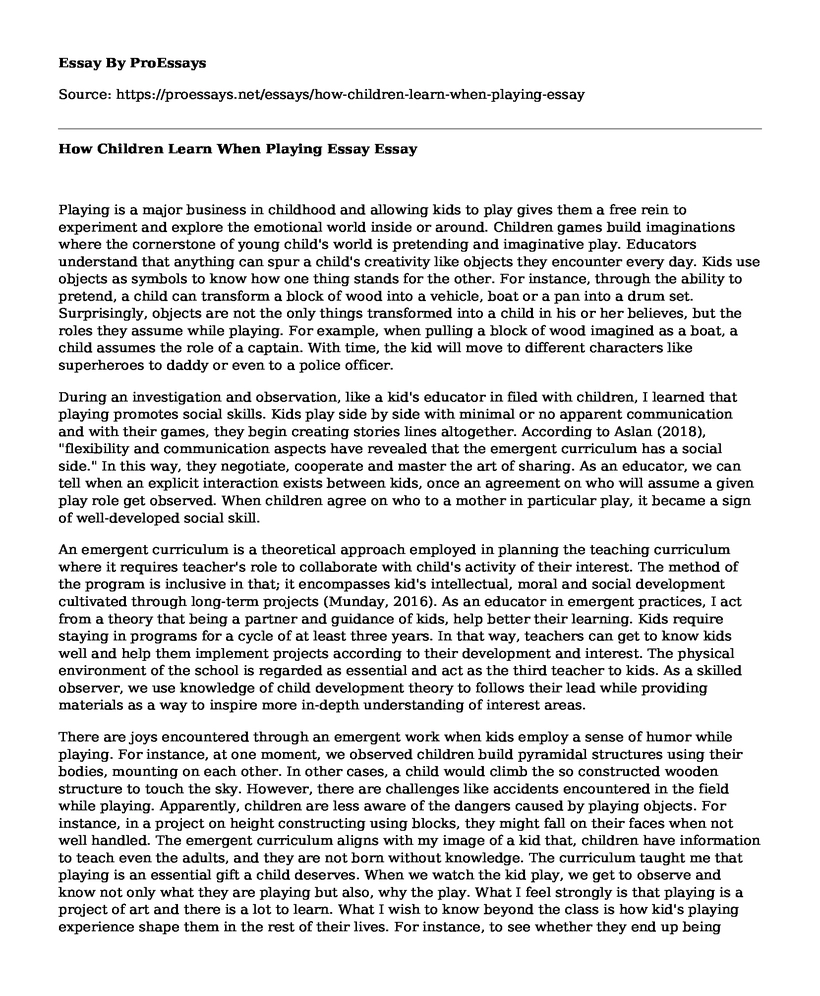Playing is a major business in childhood and allowing kids to play gives them a free rein to experiment and explore the emotional world inside or around. Children games build imaginations where the cornerstone of young child's world is pretending and imaginative play. Educators understand that anything can spur a child's creativity like objects they encounter every day. Kids use objects as symbols to know how one thing stands for the other. For instance, through the ability to pretend, a child can transform a block of wood into a vehicle, boat or a pan into a drum set. Surprisingly, objects are not the only things transformed into a child in his or her believes, but the roles they assume while playing. For example, when pulling a block of wood imagined as a boat, a child assumes the role of a captain. With time, the kid will move to different characters like superheroes to daddy or even to a police officer.
During an investigation and observation, like a kid's educator in filed with children, I learned that playing promotes social skills. Kids play side by side with minimal or no apparent communication and with their games, they begin creating stories lines altogether. According to Aslan (2018), "flexibility and communication aspects have revealed that the emergent curriculum has a social side." In this way, they negotiate, cooperate and master the art of sharing. As an educator, we can tell when an explicit interaction exists between kids, once an agreement on who will assume a given play role get observed. When children agree on who to a mother in particular play, it became a sign of well-developed social skill.
An emergent curriculum is a theoretical approach employed in planning the teaching curriculum where it requires teacher's role to collaborate with child's activity of their interest. The method of the program is inclusive in that; it encompasses kid's intellectual, moral and social development cultivated through long-term projects (Munday, 2016). As an educator in emergent practices, I act from a theory that being a partner and guidance of kids, help better their learning. Kids require staying in programs for a cycle of at least three years. In that way, teachers can get to know kids well and help them implement projects according to their development and interest. The physical environment of the school is regarded as essential and act as the third teacher to kids. As a skilled observer, we use knowledge of child development theory to follows their lead while providing materials as a way to inspire more in-depth understanding of interest areas.
There are joys encountered through an emergent work when kids employ a sense of humor while playing. For instance, at one moment, we observed children build pyramidal structures using their bodies, mounting on each other. In other cases, a child would climb the so constructed wooden structure to touch the sky. However, there are challenges like accidents encountered in the field while playing. Apparently, children are less aware of the dangers caused by playing objects. For instance, in a project on height constructing using blocks, they might fall on their faces when not well handled. The emergent curriculum aligns with my image of a kid that, children have information to teach even the adults, and they are not born without knowledge. The curriculum taught me that playing is an essential gift a child deserves. When we watch the kid play, we get to observe and know not only what they are playing but also, why the play. What I feel strongly is that playing is a project of art and there is a lot to learn. What I wish to know beyond the class is how kid's playing experience shape them in the rest of their lives. For instance, to see whether they end up being characters they mimic during the childhood.
References
Munday, A. (2016). HiMama - What is Emergent Curriculum?. Himama.com. Retrieved 16 April 2018, from https://www.himama.com/blog/what_is_emergent_curriculum
Aslan, O. M. (2018). From an Academician's Preschool Diary: Emergent Curriculum and Its Practices in a Qualified Example of Laboratory Preschool. Journal of Curriculum and Teaching, 7(1), 97.
Cite this page
How Children Learn When Playing Essay. (2022, May 09). Retrieved from https://proessays.net/essays/how-children-learn-when-playing-essay
If you are the original author of this essay and no longer wish to have it published on the ProEssays website, please click below to request its removal:
- Research Paper on Online Learning
- Pros and Cons of the Knight Commission - Paper Example
- Evaluation of the Application of Educational Theory Paper Example
- Personal Statement for Law School Paper Example
- Essay Example on School-Age Child Care: Quality Matters for Kids' Growth
- Essay Example on Four Parenting Styles: Benefits and Outcomes
- Social Media Use - Essay Example







